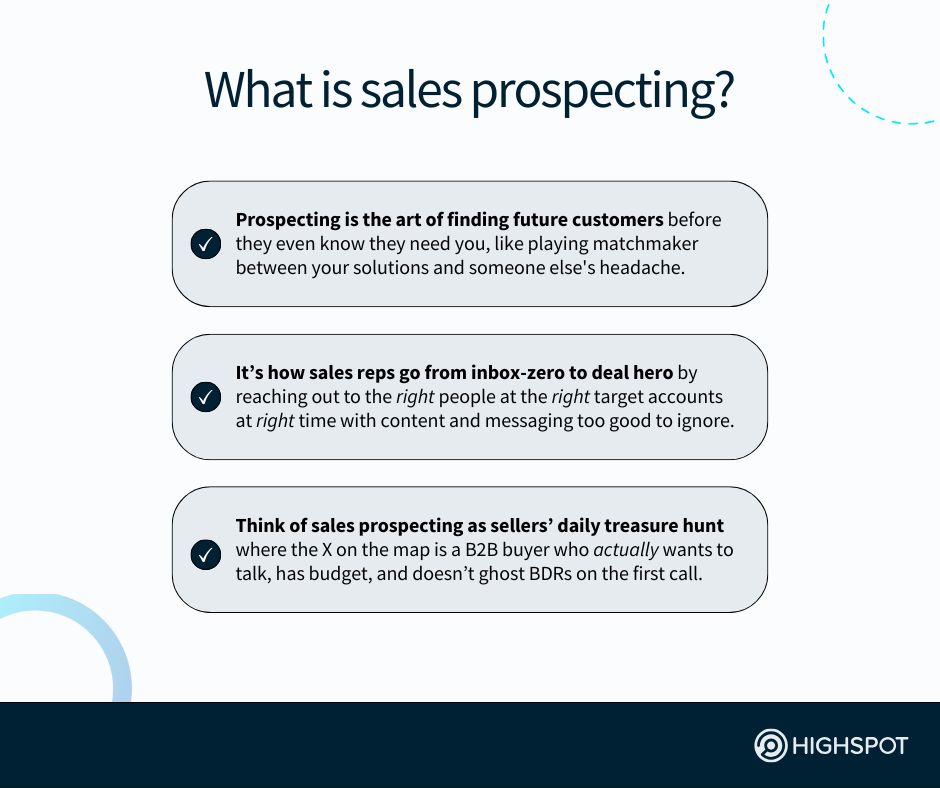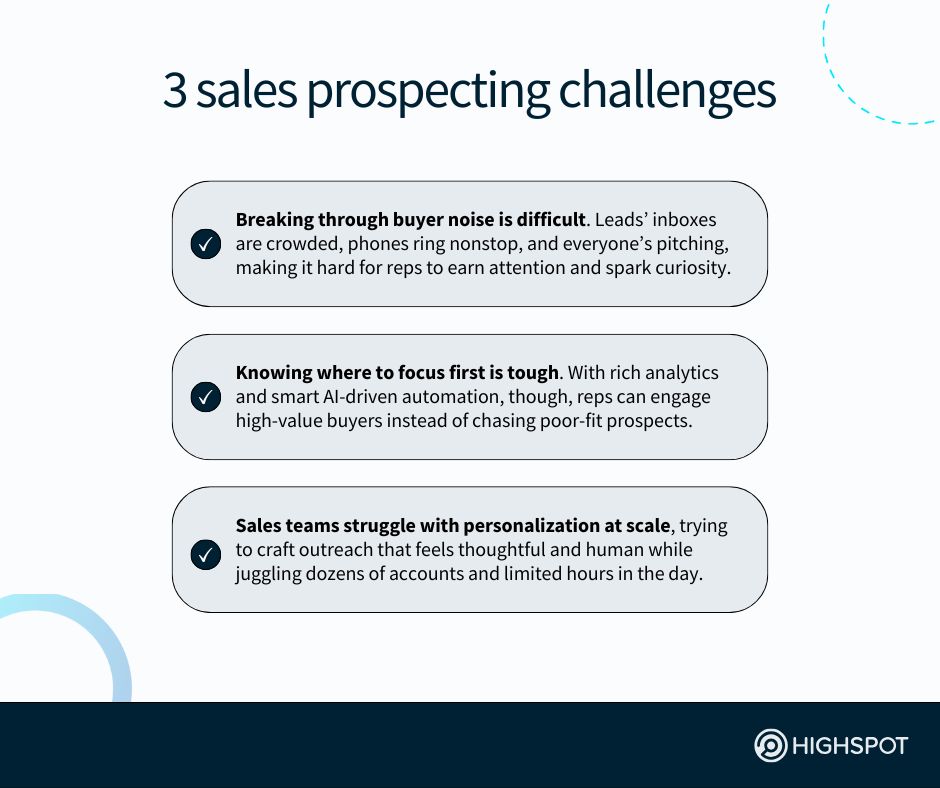Key Takeaways
- The modern sales prospecting process involves more than dialing numbers and crossing fingers. It’s about turning curiosity into conversations and new contacts into qualified, close-ready sales leads.
- The strongest sales prospecting strategies don’t entail reps reaching out to random buyers. Rather, they require sellers to use real-time insights to connect with high-intent potential customers.
- The best sales prospecting tools help BDRs spend less time guessing what messaging and content to deliver when and where and more time engaging potential buyers on their preferred channels.
Imagine preparing for a discovery call with a dozen different tabs open.
You’ve got your inbox, LinkedIn Sales Navigator, your sales engagement tool, your CRM system, a few analytics dashboards, and a Slack thread with marketing about recent lead generation activities and pipeline coverage all on screen.
That juggling act eats into your selling time before you’ve even had the chance to say hello. If that sounds familiar to you and your sales team, you’re not alone.
Highspot’s State of Sales Enablement Report 2025 found that nearly half of companies still struggle to engage new leads, noting that providing a delightful customer experience to potential buyers remains a continual challenge for them.
Even with almost half of go-to-market teams already using AI to streamline parts of the sales prospecting process, identifying and contacting potential customers still takes up considerable time for sales reps like you.
That’s why so many sales development representatives and account executives feel stretched thin today. Solution overload and chasing unqualified leads delay early sales conversations and slow down the entire sales cycle.
The good news is sales prospecting doesn’t have to feel like drudgery.
In fact, we know how you can implement one of the most effective prospecting strategies utilized by countless B2B sales teams today so you and other business development representatives can spend more time engaging with key decision-makers at high-quality leads and less time talking to poor-fit buyers.

What is sales prospecting?
Sales prospecting fills the funnel with leads worth your time. It’s the process of identifying, contacting, and engaging potential leads who will benefit from your product or service. You spend less of your day chasing dead-ends, speed up your sales cycle, improve sales velocity, and stay aligned with the broader sales methodology.
Prospecting kicks off the sales cycle. Sales reps work the top of the funnel, filtering prospects until account executives can convert them into satisfied customers. It combines outbound prospecting, such as cold calls, cold emailing, and direct mail, with inbound prospecting generated from marketing efforts.
The sales prospecting process is a crucial early step in the overall sales process, helping sales teams like yours pinpoint strong-fit buyers before competitors do, in turn increasing efficiency and boosting pipeline quality from day one.
How does prospecting help reps attract potential customers?
What makes sales prospecting important is that it empowers reps to allocate more time having meaningful conversations around buyers’ pain points and needs that convert at a high rate, leading to accelerated deal velocity.
While sales prospecting and lead generation are two sides of the same coin, the former focuses mainly on lead qualification and intent, ensuring the pipeline is not just full, but filled with accounts that are truly ready to purchase.
Effective prospecting enables sales teams such as yours to conduct outreach to the right personas—those who match their ideal customer profile—with the right message at the right time, ensuring every touchpoint drives momentum.
Using sales prospecting and lead generation together, these targeted engagement activities help you find prospects who are in the market for solutions like yours. That means your organization can fill its collective funnel with potential customers who have genuine interest in your products or services.
| Effective sales prospecting efforts | Why it works |
|---|---|
| Cold calling stakeholders at strong-fit accounts | A well-timed cold call can open doors when paired with buyer research and relevance. It’s a staple in any effective sales prospecting strategy today. |
| Emailing leads based on recent buyer behavior | Trigger-based, personalized emails outperform broad, segmented blasts. When tied to actions like downloads or views, they can spark real lead generation momentum. |
| Using advanced, AI-powered sales prospecting tools | The best sales prospecting tools surface next-best actions and insights so reps focus on high-value outreach instead of digging through data. |
| Mapping accounts and roles in your CRM system | Clear account mapping by managers aligns the sales process to buyer needs—improving personalization and reducing time spent on unqualified contacts. |
| Collaborating with cross-functional sales teams | Sales prospecting improves when reps share insights from customer success, product, or marketing, especially when targeting complex or multi-threaded accounts. |
| Following up with marketing-generated inbound leads | Inbound leads are already showing interest. Prioritizing them increases connect rates and shortens the sales cycle when outreach happens quickly. |
| Personalizing messages to showcase value | Tailoring outreach to clearly connect with the buyer’s goals and how your products or services help makes the message more relevant and hard to ignore. |
The modern sales prospecting process
Even though buyer behavior has evolved, with 92% of B2B buyers entering the process already considering a vendor and interactions spanning 10 channels (more stakeholders, more self-research, and more reliance on social media channels), the core stages of prospecting remain relevant regardless of industry:
Develop targeted prospect lists using CRM system data
Your CRM system contains important prospecting data, including past deals, lost opportunities, and marketing-qualified leads (those who have engaged with content, attended a webinar, or have repeated website visits).
When you augment prospect lists with this extra data and then add buying signals you find on LinkedIn and other social media platforms (through proactive social selling), you increase the odds your prospecting techniques hit the mark.
Highspot’s 2025 sales enablement report also shows that tool integration matters: Companies with well-connected tech stacks are 42% more likely to increase sales productivity. That means sales reps can spend more time engaging leads and less time toggling across disconnected, siloed selling solutions.
A go-to-market enablement platform like Highspot, specifically, can supercharge this step by helping you surface hidden buying signals and unify fragmented buyer engagement data into one streamlined view of your target accounts.
For instance, using Highspot, you are able to connect, integrate, and activate data from your CRM alongside insights, analytics, and other sales intelligence and prospecting tools to make your outreach more informed and more effective.
The simple truth is that sales teams that inform their prospecting with this richer context deliver personalized, timely outreach that resonates with leads.
Personalize outreach to make buyers feel seen and heard
Speaking of outreach, it’s no secret that generic sales emails almost always end up in the trash, but buyers become wary when vendors overstep their boundaries.
Many leads are concerned that companies already have too much personal data, and Gartner research shows that traditional personalization at the wrong moment can leave more than half of customers feeling rushed, overwhelmed, or regretful.
The solution isn’t to abandon personalization altogether. Rather, redesign it by involving the qualified leads you connect with in shaping their customer experience.
Active personalization approaches that rely on interactive or consultative tactics, like gamified assessments, can help you directly ask buyers for their engagement preferences and business needs without coming off as pushy.
Meanwhile, creating a digital sales room where buyers guide their own path and have direct access to all sales messaging and collateral tied to deal discussions can help them get the product or service info they need when they need it.
According to Gartner, this style of personalization makes customers 2.3 times more likely to make vendor purchase decisions with confidence, while Forrester notes that buyer value personalization when it delivers customer value.
Highspot customer Pluralsight is transforming buyer engagement by centralizing and personalizing content across every step of the sales cycle in our GTM enablement platform.
Use an omnichannel approach to engage qualified leads
Personalization alone isn’t enough if you are only reaching buyers in one place. Your potential customers move fluidly between a variety of platforms, making omnichannel the norm. Prospecting now mixes social selling on LinkedIn, traditional phone calls, cold emailing, and virtual selling environments.
McKinsey’s 2024 B2B Pulse Survey shows just how far buyers have shifted.
Case in point: Nearly three-quarters (73%) of key decision-makers are comfortable spending more than $50,000 in a single transaction through remote or self-service channels (without speaking to sales reps), while 39% would spend $500,000 or more and 20% are willing to pay over $1 million online.
This proves digital is a trusted path for small- and big-ticket purchases.
Social prospecting ensures visibility where potential customers already spend time, while live sales meetings and digital rooms create buyer-driven engagement.
The takeaway here is simple: Delivering a seamless experience across all channels in the B2B buying journey, not just one single channel, is absolutely critical today.
Address prospects’ biggest pain points in each interaction
Your buyers naturally expect solution providers to understand their pain points.
IDC research shows that today’s B2B buyers “expect you, as a vendor, to understand and provide solutions for their challenges, jobs to be done, and business outcomes.” Meeting this expectation early sets a positive tone for the entire relationship.
That’s why every interaction should connect back to the prospect’s real business problems, rather than just providing a product feature dump. Custom-tailored messaging, case studies that mirror their industry, and consultative questioning show you’re invested in solving their biggest challenges.

B2B sales prospecting tips: Best practices for today’s sales professionals
You, other sales reps, and your GTM leaders routinely work together to refine your sales plan and test and tweak prospecting methods to learn what works and what doesn’t. But in competitive markets, experimentation isn’t enough.
You need every edge to spot and win over leads before your rivals do. Thankfully, there are some best practices that can help you sharpen your prospecting.
Balance inbound and outbound prospecting approaches
Inbound leads are gold, but they tend to run out quickly.
Relying only on them is just not enough. You should diversify by balancing inbound prospecting with outbound prospecting methods, including cold calls and emails, social selling, and referrals. This ensures a healthier funnel and steadier pipeline growth.
Cold outreach does still work for today’s sales reps, though.
Cold calling, in particular, provides immediate feedback that you can’t get from email or social media posting. While connect rates can be low, when the call is well-timed, you can qualify and even advance potential buyers along the funnel quickly.
Send custom sales enablement content to spark curiosity
Generic PDFs and sell sheets don’t cut it anymore in your prospecting efforts. Today’s buyers expect relevance, clarity, and value before they even book a call. That’s why tailoring content to specific pain points and vertical challenges is vital.
Use your mix of sales engagement tools to send dynamic, personalized content prospects’ way that directly reflects your buyers’ unique priorities and use cases. Incorporate intel from past conversations, job titles, and recent activity.
It’s one of the most effective sales prospecting methods for warming up sales leads and earning trust early in the sales process. Better content equals more opens, replies, and next steps, especially when content feels made just for them.
Utilize trigger events and buying signals to time outreach
Great outreach isn’t just about what you say.
It’s also essential to know when to share messages with would-be buyers. Use data related to purchase intent, funding rounds, leadership changes, product launches, and other account-based selling insights to connect with leads when they’re most open to change.
Timing your messaging around these trigger events makes your sales prospecting approach feel proactive, not pushy. High-performing reps monitor social media, press releases, and CRM engagement to hit when it matters most.
Align outreach to urgency by syncing your selling cadences with real-time behavioral activity, rather than guessing. In your sales process, these time-sensitive touchpoints can dramatically increase open rates, replies, and meetings booked.
Leverage LinkedIn for warm introductions to sales leads
Referrals and warm intros still outperform any outbound prospecting approach.
LinkedIn Sales Navigator is a phenomenal sales prospecting tool that can help you find mutual connections, track account activity, and spot new contacts at key accounts. So, use it to bypass the dreaded cold phone call and build rapport with individuals who are likely to buy faster.
The goal isn’t to pitch. It’s to humanize. Even a casual message can tee up a valuable first call when it’s built on shared connections or common ground.
Just don’t forget to solely follow target companies and accounts that match your ideal customer profile for timely alerts and context. A little networking effort can unlock a lot of high-quality potential leads that skip the cold start entirely.
Test and refine messaging variants to different segments
What resonates with an enterprise CIO might fall flat with a startup CMO. Tailoring messaging starts with segmenting audiences by demographic data, pain points, and purchase intent. That said, it doesn’t stop there.
Testing multiple versions of your emails and call scripts can show you what sticks and what gets ghosted. Don’t let cold emailing become a numbers game. Use the right sales tools to A/B test subject lines, CTAs, and value props, then scale what works.
Use sales agents and AI role play to improve prospecting
As we’ve discussed, the increasing use of AI for sales is reshaping prospecting.
For instance, our recent sales enablement research found that the go-to-market teams using artificial intelligence in their sales coaching programs are 20% more likely to improve revenue outcomes and 23% more likely to attain sales quota.
By identifying skill gaps and reinforcing them through realistic sales role play using an AI-powered GTM enablement platform like Highspot with role-play capabilities, you can sharpen your outreach without putting live opportunities at risk.
Highspot’s AI sales agents can also help with targeted sales prospecting.
Our agentic GTM platform is trained to simulate realistic buyer objections, product-specific questions, and common pushbacks, enhancing reps’ sales pitch precision and confidence. These agents adapt dynamically, using deal-stage and buyer-behavior data to simulate more impactful prospecting efforts.
The result is sharper messaging, stronger delivery, and smarter deal execution.
Analyze the effectiveness of sales plays and collateral
Making the most of AI is one thing. Measuring how it helps is another.
Unified sales analytics provides a clear view of which prospecting strategies move deals forward and which do not yield results. Highspot Nexus™, our AI and analytics engine, turns every go-to-market signal, spoken, shared, or shown, into role-based, real-time guidance for your entire sales team.
Instead of relying on gut instinct, you can refine messaging, content, and outreach based on rich intel doubling down on what works and cutting what doesn’t.
“Organizations everywhere struggle to correlate action with impact—it’s why translating strategy into efficient execution is such a common challenge,” Highspot’s Take the Guesswork Out of GTM Performance guide explains.
“Now, however, innovation in analytics is making it possible to understand precisely how go-to-market efforts impact business outcomes,” the guide continued.
Answers to sales prospecting FAQs
It’s obvious the B2B sales funnel has become more complex in recent years, and today’s buyers expect a lot more from vendors. That means leveling up your sales strategy to win new business consistently and at scale requires knowing which specific sales prospecting tools and techniques can help you accelerate revenue.
Below are some FAQs we hear from GTM leaders about how their sales teams can best connect with potential leads, better manage their sales pipeline, and—ultimately—conduct more engaging sales discussions that close deals.
How can sales reps get higher reply rates on cold outreach?
Cold outreach works best when it feels relevant to the prospect’s business. Use good prospecting techniques like referencing an industry challenge, sharing a brief insight, highlighting a common connection, or asking a consultative question. Small touches of interest build trust and get replies.
Can my sales team personalize sales engagement at scale?
Yes, but personalization has to add value. Prospecting tools can segment by role, industry, or trigger events, while you tailor messages to align with business goals. This balance makes prospecting authentic and shows relevance without overstepping.
What sales prospecting tools find high-intent prospects?
The best prospecting tools integrate CRM data, buying signals, and intent data from social media and search engines. These tools surface leads that are already showing interest, so you can focus sales efforts on the best sales pipeline opportunities.
When should I send sales emails to cold leads?
Early morning mid-week emails tend to have better open rates, but the best approach is to test across your own marketing activities. Pairing email with other outbound sales touchpoints, such as calls or LinkedIn messages, also increases response rates.
What if I get no responses after multiple sales touches?
Don’t repeat the same outreach over and over. Rotate prospecting and lead gen tactics: change your messaging angle, share a new piece of content, or switch channels. If there’s still no response, revisit whether the lead truly fits your prospecting definition of a qualified lead.
What metrics should I track for sales prospecting success?
Key metrics include conversion from MQL to meetings, pipeline influence, and revenue impact. Sales operations can track response rates, touches per opportunity, and time-to-meeting to help you determine which are your best prospecting strategies.
How can I make outbound sales efforts not feel like spam?
The difference between spam and good prospecting is the value you add. Show interest in solving the prospect’s business challenges. Share insights, case studies, or benchmarks tied to their role or industry. Value-driven outbound sales build trust and avoid the “spray and pray” trap.
How do I tie sales prospecting with our GTM initiatives?
Connect prospecting to your company’s primary marketing campaigns and growth priorities. Use the same data and prospecting tools your marketing team relies on, so your focus is on the accounts that were brought in through purposeful activities, such as product launches or campaigns.




